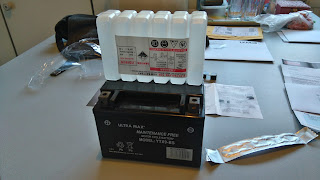Later that day when I came out from work the starter solenoid merely buzzed, which led to the great disgrace of having the second-in-command push me up and down the cap park trying to get the thing started. It didn't want to know until I'd borrowed a screwdriver off him (further disgrace) and removed the connector block from the headlight as there is no switch to turn the light off. After this it fired up no problem and, after refitting the headlight (my eyes!!) I managed to ride home. The light was dim, the dash flickered and eventually died, but I did make it home - I had less than 9v in the battery by the time I got to safety.
I decided this was likely due to the battery being well over 3 years old and being a cheaper Thai Yuasa, I'd once had a battery fail similarly on the CB250 - that one could barely power the neutral light after a warm day sat outside. So..
Those reading this from the UK may know that it is illegal to sell batteries with the acid still separate as certain scummy elements of society can't be trusted to not squirt it in people's faces. This was sold as "acid-added" but it wasn't. I'm okay with this, I just found it amusing. It's not like the police are going to check what's being sent through the post! Anyway, running voltage with the light in:
I have a sneaking suspicion that 12.4v isn't quite right. Also the light looked decidedly yellow:
If it jumps considerably when I disconnect the headlight that may mean I have a charging problem..
14.2v. Bollocks.
I refitted the headlight and decided to give it a run to work anyway, perhaps it'll charge happily at higher revs? It did not, running along read 12.7v and by the time I got home I had around 10v, no doubt helped by the new and freshly charged battery. Time to check the resistance and AC voltage of each of the stator coils.. Which means time to take the tank off yet again. I'm becoming quite good at it now!
The connector is a big one at the front left with 3 yellow wires running into it. When running some coils produced 39VAC while others managed 25VAC, and one set of coils (i.e. one wire in the connector) read 10 ohms of resistance while the other two read 2.8 and 3.2 ohms. Yep I've got my first stator problem to deal with, superb.
So, here's a guide of how to replace the stator on your 250SL. I have a funny feeling this might be a popular post in the future! Start by removing the stupid belly pan that does nothing but get in the way, then remove the front sprocket cover and the cover of the reducing gear for the starter motor. This is all straight forward, just bolts. Also remove the neutral wire because it'll just be in the way if you don't.
You will also need to drop the oil as the alternator on the 250SL runs in oil, so when you take the cover off all that oil will fall out. This is made particularly fun because the bike does not have a centre stand so it will keep dripping for as long as you leave the cover off.
Now, how to get the cover off! Remove all the bolts that hold it on (including the two that were behind the starter motor reducer gear!), unclip the 3 wire connector and unthread it from the rest of the wires that work their way up the frame aaaand it should pull off. I tried this to no avail. I tried rubber malleting it to no avail. I tried levering it off against the starter motor to no avail. In the end I used some washing line and brute force..
A good couple of tugs had it free. There is a seal around the starter motor shaft that is very tight, KLX250 owners have the same problem.
Hmmm. Doesn't look too good.
This bit seems alright though, thank goodness. What a pain that would be to get off the crank!
So, simply remove the two JIS screws that clamp the wires in place and then remove the three caphead screws that bolt the stator in place.
There was no threadlock on the bolts, they were just tight. Do use the correct bit for the screws, if the driver cams out and you mess them up you could have a real job on your hands. With the stator free you can closely inspect for damage (as if you'd need to!).
Well there's your problem. At least I was right! I managed to get hold of a replacement stator from an ebay breaker who had broken a 1500 mile bike, mine for £78.95. I noticed there were also some Chinese units for sale for around £50 but I cannot comment on them, though the pictures looked exactly the same as the Kawasaki ones. Bolt the stator in place and clamp the wires without pinching them (which seems to be all they want to do..). Don't bother with torque specs, the fasteners aren't new and the threads aren't clean.. Just do them up so they won't come loose.
With the cover bolted into place the only other difficult part is refitting the starter motor reducing gear. This is difficult because you need to get the teeth to line up, for reference the gear needs to go on this far:
Just keep trying until it fits. After that simply bolt everything back on (no I didn't use any sealant or gasket on the reducer gear cover, no it doesn't leak), reconnect your electrical connectors and put the tank and all the plastics back on (if you're confident). Refill the engine with oil and it's time to give the starter a prod..
Job's a good 'un. What'll be next I wonder..?


















No comments:
Post a Comment